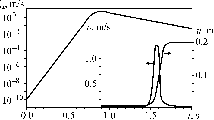Abstract
The propagation of slip along a pre-existing frictional plane is formulated for the faults containing interstitial fluid. When normal and shear stresses satisfy the effective frictional law, a frictional sliding occurs stably or unstably, depending on the inhomogeneities of the surface. For a slip to rapidly sweep the surface, the pore pressure of fluid must exceed the critical value that is related to the physical or geometrical irregularities of the surface. If this condition fails, stable sliding is expected, analogous to a seismic fault creep. This prediction makes the role of water in seismic faulting more clear.
Access this chapter
Tax calculation will be finalised at checkout
Purchases are for personal use only
Preview
Unable to display preview. Download preview PDF.
Similar content being viewed by others
References
Andrews, D. J. (1976), Rupture propagation with finite stress in antiplane strain, J. Geophys. Res. 81, 3575–3582.
Bilby, B. A. and Eshelby, J. D., Dislocations and the theory of fracture, in H. Liebowitz (Ed.), Fracture, I., Academic Press, New York, 1968, pp. 99–182.
Bowden, F. P. and Tabor, D., The friction and lubrication of solids, I., Clarendon Press, Oxford, 1971.
Frank, F. C. (1965), On dilatancy in relation to seismic sources, Rev. Geophys. 3, 485–503.
Healy, J. H., Rubey, W. W., Griggs, D. T. and Raleigh, C. B. (1968), The Denver earthquakes, Science 161, 1301–1310.
Hubbert, M. K. and Rubey, W. W. (1959), Role of fluid pressure in mechanics of overthrust faulting: I. Mechanics of fluid-filled porous solids and its application to overthrust faulting, Bull. Geol. Soc. Am. 70, 115–166.
Husseini, M. I., Jovanovich, D. B., Randall, M. J. and Freund, L. B. (1975), The fracture energy of earthquakes, Geophys. J. R. astr. Soc. 43, 367–385.
Ida, Y. (1972), Cohesive force across the tip of a longitudinal shear crack and Griffith’s specific surface energy, J. Geophys. Res. 77, 3796–3805.
Ida, Y. (1973), The maximum acceleration of seismic ground motion, Bull. Seismol. Soc. Am. 63, 959–968.
Ida, Y. (1975), Analysis of stick-slip and earthquake mechanism, Phys. Earth Planet. Inter. 11, 147–156.
Kostrov, B. V. and Nikitin, L. V. (1970), Some general problems of mechanics of brittle fracture, Arch. Mech. Stosowanej, 6, 749–776.
Mogi, K. (1967), Earthquakes and fractures, Tectonophysics 5, 35–55.
Nur, A. (1972), Dilatancy, pore fluids and premonitory variations of t s /t p travel times, Bull. Seismol. Soc. Am. 62, 1217–1222.
Ohnaka, M. (1975), Frictional characteristics of typical rocks, J. Phys. Earth. 23, 87–112.
Ohtake, M. (1974), Seismic activity induced by water injection at Matsushiro, Japan, J. Phys. Earth 22, 163–176.
Oike, K. and Kishimoto, Y. (1977), The Yamasaki fault as a test-field for the earthquake prediction, (in Japanese), Proceeding of Symp. on Earthquake Prediction, Tokyo, Japan, 1976, pp. 83-90.
Rice, J. R. (1975), On the stability of dilatant hardening for saturated rock masses, J. Geophys. Res. 80, 1531–1536.
Scholz, C. H., Sykes, L. R. and Aggarwal, Y. P. (1973), Earthquake prediction: A physical basis, Science 181, 803–810.
Author information
Authors and Affiliations
Editor information
Editors and Affiliations
Rights and permissions
Copyright information
© 1978 Birkhäuser Verlag Basel
About this chapter
Cite this chapter
Ida, Y. (1978). Propagation of Slip along Frictional Surfaces. In: Byerlee, J.D., Wyss, M. (eds) Rock Friction and Earthquake Prediction. Contributions to Current Research in Geophysics (CCRG), vol 6. Birkhäuser, Basel. https://doi.org/10.1007/978-3-0348-7182-2_24
Download citation
DOI: https://doi.org/10.1007/978-3-0348-7182-2_24
Publisher Name: Birkhäuser, Basel
Print ISBN: 978-3-0348-7184-6
Online ISBN: 978-3-0348-7182-2
eBook Packages: Springer Book Archive



